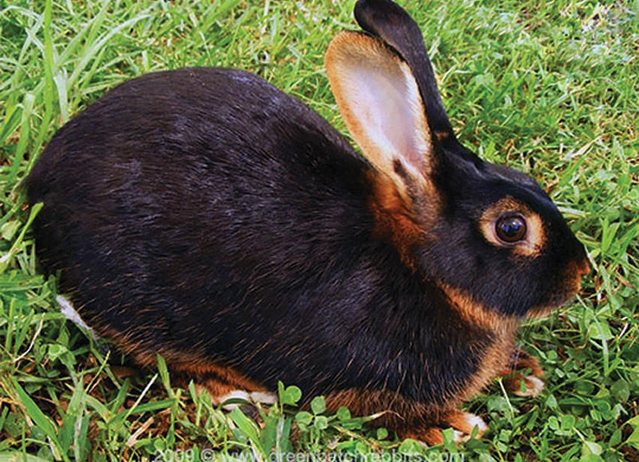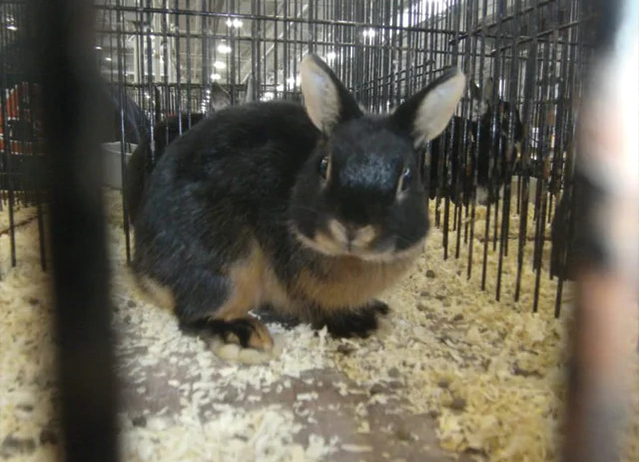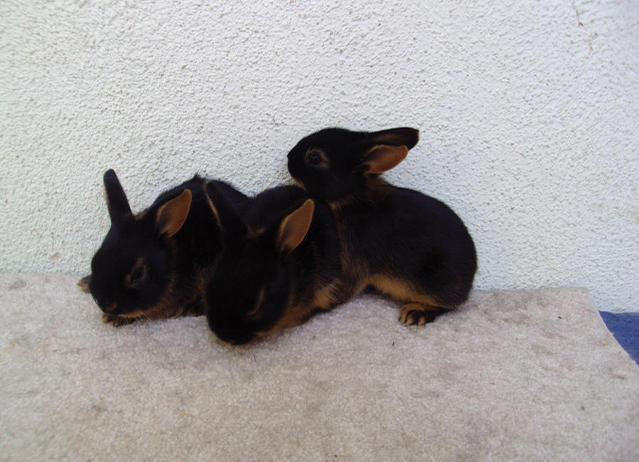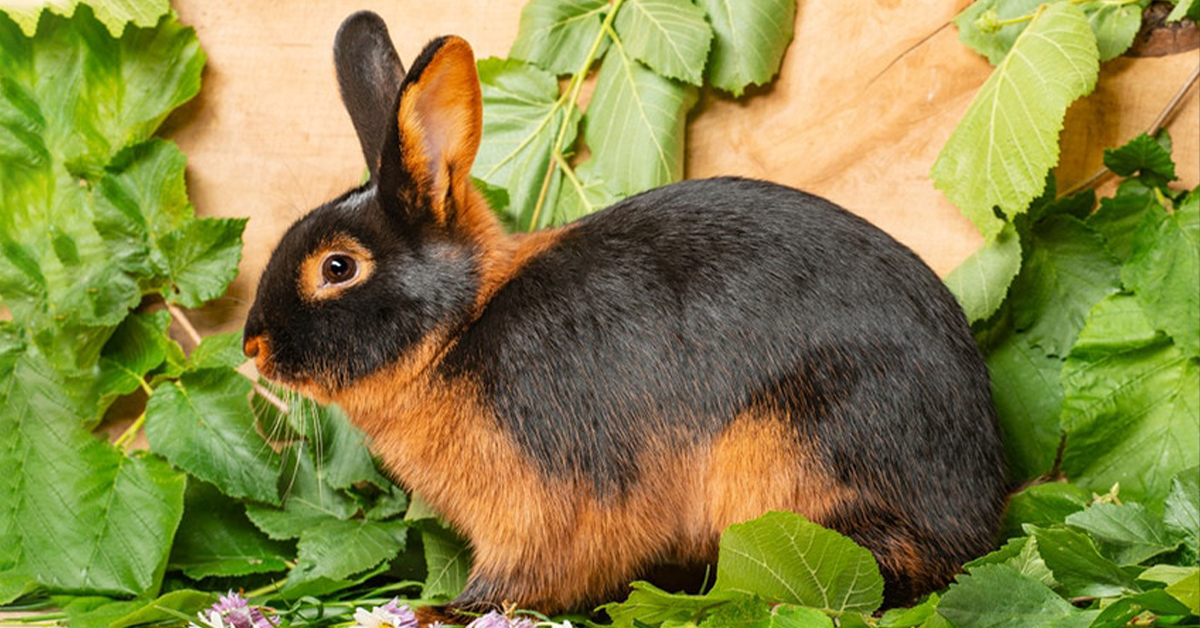About Tan Rabbit
| Weight | 4-6 lb |
| Lifespan | 8-10 years |
| Body Shape | Full Arch |
| Best Suited For | Singles, House Rabbits, Families with older children, Indoor Rabbits, Outdoor Rabbits |
| Temperament | Intelligent, energetic, sweet, friendly |
| Size | Medium |
| Ears | Upright |
| Fur Type | Short and Dense |
| Eye Color | Brown |
| Purpose | Exhibition /or companion |
| Color Pattern | Tan (Agouti pattern) |
| Comparable Breeds | Harlequin Rabbit, Thrianta Rabbit |
Tan Rabbit Breed History/Origin
Tan rabbits were discovered in England around 1880 when some wild rabbits and domestic rabbits were crossbred. Breeders started braising and refining the tan-marked rabbits so the breed was very popular. By the 1920s in England, black, blue, and lilac Tan Rabbits had been established. Tan Rabbits, a decade later, migrated to the United States, and Tan Rabbit Specialty Club was formed around 1936 as the first of its kind. However, this club was later replaced by the Tan Rabbit Specialty Club in 1960, but it was only in the 1990s that tan rabbits showing full-arched features became popular. It’s a combination of domestic Dutch and wild European rabbits. Additionally, to get the tan color of the fur, the program was further improved through selective breeding of Belgian Hare. This also mixed the genetic makeup of the breed and formed it into the Tan breed that it is at present. After the breed standard was given major revisions, it is still Tan rabbit that won Best in Show at the American Rabbit Breeder’s Association (ARBA) Convention in 2003, and people still pay a great deal of attention to it.
Tan is one of the ARBA-accepted rabbit breeds that few have a fully arched body.

Overall Description
The Tan is one of the only rabbit breeds listed by ARBA that have a fully arched body. This means the nape of the neck has an arch that is smoothly running on the shoulders, midsection, and hips. A slender, well-balanced trunk is the typical physique of the Tans and they have big ears, standing straight on top of the head, in addition to stretched-out legs.
Tan Rabbits are not just beautiful, funny, and adorable, but they are also clever, curious, and extremely active animals. This means they are not your usual pet rabbit, they are very active and they can be difficult to adapt especially to beginners. Nonetheless, if you have had rabbits and are willing to put in extra effort, they will become your favorite. So, these buns will cost, but how much exactly? Do they like living with children and other domestic pets? And, to sum up, which way to feed, handle, and make the rabbit move, is the best? Let’s dive into it!
Coat
Tan rabbits have shiny flyback fur. Like most rabbits, not much work is required to keep it clean. Instead, one needs to just wipe them. Bathing a rabbit is a huge stressor to it and may even result in death. All things being equal, spot-clean your rabbit with a clammy fabric at whatever point fundamental (hares are by and large clean creatures, so proprietors don’t need to stress a lot over cleanliness).
Hares will shed more than expected two times per year, so you will see an expanded measure of stray hairs in your garments and around your home during these times. To avoid this, brush your hair outside 1-2 times each week with a slicker brush during weighty shedding periods; any other way, prepping your Tan Bunny once like clockwork ought to be adequate.
Tan Rabbit Colors
While reproducing full-curved rabbits, the Tan is the most straightforward to be show-commendable as each tan pack delivered will continuously have similar varieties as the buck and doe parent. All Tan rabbits have a red-orange feature design on a generally dull coat (which can be blue, lilac, chocolate, or dark); the dim concealing is on the Tan’s back, head, and sides. The tan markings are tracked down within the ears, cheeks, nostrils, around each eye, the underside of the tail, gut, chest, and the scruff of the neck.
Tan hares have shiny flyback fur that is not difficult to keep up with.

Care Requirements
It is necessary to choose the right type of pellets for your rabbits to keep them healthy. The diet should not only consist of hay but also be supplemented with pellets and some of the vegetables, leafy greens, and fruits of your choice. Nitrification of rabbits with fresh vegetables is an option at home but if you fail to research the sleuth of what are the vegetables that are the best and highly nutrified for your rabbit’s health that will be hazardous to the health of your rabbit and some of those will be not seeding enough nutrient value to the animals.
The rabbit has to be guarded both when it’s inside and outside its enclosure. Thus, Pet rabbits are usually healthier in a setting where they can be seen from indoors as owners are more than likely to remember to feed them, and cold weather effects are lessened to a certain level. You could use wire mesh or wood to make outdoor enclosures, and you need a platform to raise them off the ground especially during bad weather conditions like tornadoes/hurricanes, etc., as well as potential predators. When the indoor enclosure is the one in question, be sure to get one wired in and have a solid bottom that holds the bedding. A thin layer of feces on bedding should be cleaned every day, and you should change the bedding completely at the end of the week. If it were not that, this breed is so jolly and high-spirited that Tan rabbits are one of these animals that will not be comfortable without enough space to run and jump.
Training
The best part about Tan Rabbits is that, compared to other buns, they don’t require that much training to participate in a show. They’re already wired to be attention-seeking and love showing off—just what a good show bunny needs. On the downside, Tans are quite active pets that rely on positive reinforcement to be happy. Also, in case you have recently purchased the bun a crate or hutch, you will have to allow the pet some time to acknowledge it as its new home.
Lock up the hutch regularly so that the rabbit knows it is supposed to stay inside. toilet training comes next, and it takes quite a bit of effort. What you do is put the bun and his droppings in the cage/hutch each time he goes to the bathroom outside. Place the dung in the litter box so that the smell can take hold. Just keep doing that for a bit, and the Tan will start going to the toilet in the box. Clean the hutch about once every 1–2 weeks, and keep the hay nice and fresh.
Grooming
Their coat is to die for; that doesn’t mean it requires you to take long hours taking care of it. Tans require nearly no grooming at all, period. They take proper care of themselves. Does this mean that you shouldn’t wash this rabbit? No, full baths aren’t recommended, as they put the black tan rabbit through a lot of stress. You will kill the poor thing trying to bath it in the worst-case scenario.
Alternatively, you could use a spot-cleaning technique. That way, the bunny will be clean, but you won’t put it at risk. Brushing is very important, though; it does a great job of removing dead hair. Losing a session or two, and that fur will end up on the carpet, furniture, or even inside the little guy’s stomach. It is once a week during the “normal” days and twice a week during the shedding season.
Health Issues
These black tan rabbits are normally fit and healthy with a life expectancy of 8-10 years but small litters of around 4 kits. Check these rabbits daily for signs of:
- Flystrike – Flystrike (also known as Myiasis) appears when a fly lays its eggs on a rabbit’s skin and the rabbit’s skin is scratched, because of the dirt around the bottom, wet fur, or a wound.
These eggs hatch out and the maggots then eat their way into the rabbit’s skin. This can happen within a short time, and it may lead to death.
- Neutering and spaying –rabbits should be neutered or spayed early, at 4-6 months, if decided to do so.
It is the best choice to recommend as the rabbits have a higher rate of getting a serious reproductive system tumor and the tumors are cancerous also if one has not removed her ovaries it can make her calmer and she would not have behavioral problems.
- Overgrown Teeth– A rabbit’s teeth are always growing and hay is a very important part when it comes to their chewing ability. 70% of the rabbits’ total daily food consumption should be hay. By using their teeth to nibble hay, they will be protected from the uncontrolled growth of their teeth.
Besides getting their jaws and face disfigured, overgrown teeth are painful and may cause a lack of appetite. Laser technology is being used to grind down their teeth by a Vet.
- Bladder Problems – Rabbits are the only mammals that absorb all the calcium from their food and excrete it through their urine. Sometimes too much deposit of this mineral in the urine causes a condition, which is known as bladder sludging.
A rabbit’s diet should not contain large amounts of calcium-rich food to avoid taking in too much calcium.

Temperament/Behavior
Tan is an active, restless black tan rabbit that may not suit older citizens or households with small children, as sometimes the rabbit may turn elusive and then escape. On the other hand, its curious and lively personality sets it to be an excellent companion to seasoned rabbit owners and even to singles and couples looking for an energetic bunny. Tans need to be properly socialized to let them adjust to humans, which requires a lot of time spent outside of their cage.
Rabbits are naturally playful, but it’s up to the owner to figure out just what toys they like to play with. It can be something as simple as a ball or cardboard box, or it might be a specialty toy that you picked up at your local pet store. Similar to dogs and cats, every rabbit has its personality and likes to play with some toys more than others.
Most rabbits are harder to toilet train than a dog or cat, but it’s still not impossible. Placing multiple litter boxes throughout the house and praising their rabbit with treats when it is used is successful for many owners. Toilet training may be learned by your Tan rabbit with lots of patience, treats, and positive reinforcement.

3 Little-Known Facts About Black Tan Rabbit
The little-known facts about Black Tan Rabbit are as follows:
1. Each Year, the ATRSC Hosts a Black Tan Rabbit Show
In the national show, held in March, breeders from every state are free to come and join in the competition. The eventual winner gets a prize and national recognition. And it isn’t the only kind of show they have. In the fall, ATRSC has a national convention with many educational contests. American Tan Rabbit Specialty Club encourages young and old breeders to participate and win scholarships.
2. Tan Rabbits Come in Four Different Colors
There are only four types of Tan Rabbit, according to the ARBA. We have black, blue, chocolate, and lilac bunnies. So, Tans were originally black. However, not long after they were discovered, professional breeders in the UK developed the blue buns, in 1900 to be exact. The ARBA welcomed Tans as a stand-alone breed in 1908. The Chocolate rabbits made their appearance in the 1920s. From what many sources say, it was from breeding a Tan with a chocolate Havana.
Lilac was introduced in 1927. Now, the “OG” Tan Rabbits were far from the buns that we have today. You go to a breeder, ask for a Tan, and you get a sleek, shiny pet with long legs. The real Tan Rabbits were somewhat short and heavy in build. So, what has changed? Partly, it was because of the Belgian Hares introduced into the mix. We also have the shows and competitions to accuse of that.
3. They Get Aggressive During the Mating Season
Although Tan Rabbits are not the cuddliest pets on earth, they still have a soft side for people whom they love and trust. Most of the time, they are calm and cool. They get very aggressive when the mating season kicks in. Therefore, if you feel that your bunny is acting a little weird or even displaying unprovoked aggression, it will be due to the hormones that come into play during the breeding season most of the time.
Related: Dutch Rabbit

